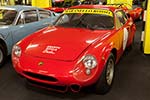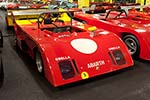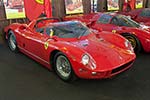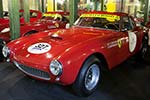
| Click here to save all images |
Maranello Rosso |
 On May 25, 1947, Franco Cortese scored Ferrari's first victory as a constructor by taking a win in the Rome Grand Prix. One of the spectators on that fateful day was the 11-year old Fabrizio Violati. This was the start of a lifelong passion for cars in general and Ferrari in particular that would culminate into one of the finest privately owned museums in the world; Maranello Rosso.
On May 25, 1947, Franco Cortese scored Ferrari's first victory as a constructor by taking a win in the Rome Grand Prix. One of the spectators on that fateful day was the 11-year old Fabrizio Violati. This was the start of a lifelong passion for cars in general and Ferrari in particular that would culminate into one of the finest privately owned museums in the world; Maranello Rosso.Violati was born in Rome in 1935 as the youngest son of a farmer and mineral water producer. He quickly developed a taste for speed and by his late teens was performing hair raising stunts on his reinforced Vespa scooter. One of his friends photographed him jumping over no less than ten wine barrels. The photograph was sent to Vespa, who were greatly impressed by the Italian 'Evel Knievel' and hired him as a works driver for a variety of races and trials.
While studying for a degree in geology, he switched from competing on two wheels to racing on four wheels. He acquired a Fiat 600 in 1959 and entered it in a variety of hillclimbs with little success. A year later the little Fiat was replaced by a much more potent Fiat Abarth 750. Unfortunately he was involved in a massive shunt that put him in the hospital for six months. Once released, his family forbade him from ever racing again. His nevertheless love for Abarths remained strong.
 In the following years Violati respected his family's wishes with one notable exception, when in 1965 he stumbled across an old Ferrari competition car that was close to being retired permanently. This soon to be scrapped Ferrari was none other than 250 GTO 3851GT that had placed 2nd in the 1962 Tour de France. He paid the princely sum of 2,500,000 lire, which was about $4,000 at the time. His family was none the wise and to keep it that way, Violati could only use his new pride and joy at night.
In the following years Violati respected his family's wishes with one notable exception, when in 1965 he stumbled across an old Ferrari competition car that was close to being retired permanently. This soon to be scrapped Ferrari was none other than 250 GTO 3851GT that had placed 2nd in the 1962 Tour de France. He paid the princely sum of 2,500,000 lire, which was about $4,000 at the time. His family was none the wise and to keep it that way, Violati could only use his new pride and joy at night.It would take the better part of ten years before Violati expanded his collection with a second Ferrari, a 250 GT. During the years inbetween he was too busy expanding the family empire and racing yachts. Shortly after acquiring the 250 GT, Violati added a competition spec, alloy bodied 250 GT SWB to his stable. From then on the collection really took off and gradually grew in size. Today it holds around 25 important Ferraris and 40 Abarths.
By the end of the 1970s, Violati could no longer resist the urge and returned to racing with his much loved 250 GTO. He raced the car with great verve, despite its ever increasing value. For Violati cars primarily had a practical purpose and he was perfectly happy with leaving the 250 GTO parked on a busy street. His yellow windshield band with the Scuderia Campidoglio, a reference to his native Rome, became a familiar sight on tracks across Europe throughout the 1980s. One the many highlights of Violati's historic racing career was winning the 1985 FIA Historic Championship.
 Violati's second racing career was not limited to historic racing alone; he participated in two editions of the 24 Hours of Le Mans with a Ferrari 512 BBLM entered by Scuderia Bellancauto and sponsored by his Ferrarelle mineral water. His most famous outing was in 1981 when he fielded a radical version of the five litre sports car fitted with a unique body penned by Amando Palanco, who had many decades before designed one of the Fiat entries for the famed Schneider Trophy. Sadly both races ended in retirements.
Violati's second racing career was not limited to historic racing alone; he participated in two editions of the 24 Hours of Le Mans with a Ferrari 512 BBLM entered by Scuderia Bellancauto and sponsored by his Ferrarelle mineral water. His most famous outing was in 1981 when he fielded a radical version of the five litre sports car fitted with a unique body penned by Amando Palanco, who had many decades before designed one of the Fiat entries for the famed Schneider Trophy. Sadly both races ended in retirements.In 1984 none other than Enzo Ferrari asked Violati to create the Ferrari Club Italia. He subsequently encouraged the racer and collector to create a museum for some his finest creations and use the name 'Maranello Rosso'. Unfortunately Ferrari did not live long enough to see the grand opening of the museum in December of 1989. Initially Maranello Rosso was located in the San Marion city centre, on top of 'Monte Titano'. In 2000 the museum moved to a purpose-built 3000 m� facility on the outskirts of the small city-state.
The ground level of the museum houses the majority of the Ferrari collection, spread into three distinct sections. The first sports early competition cars ranging from a 195 S to a 250 GT Interim. In the area connecting the first and second section the 250 GT SWB and 250 GTO raced extensively and successfully by Violati are displayed. The GTO is the obvious highlight of the collection; it has not changed hands since 1965 and is the only GTO that still has the original Modena registration.
 Lined up next are several road going Ferraris as well as an ASA 1000 GT, which in many ways is a mini Ferrari. Other cars of note in this area are a 250 GT Series I Cabriolet and a 250 GT Speciale. The final section is dedicated to more modern competition cars, which include the 365 P2/3 that was driven to victory in the 1965 Targa Florio by Nino Vaccarella and one of the 312 T3 Formula 1 cars originally raced by Gilles Villeneuve. Also proudly displayed is the unique 'Ferrarelle' 512 BBLM.
Lined up next are several road going Ferraris as well as an ASA 1000 GT, which in many ways is a mini Ferrari. Other cars of note in this area are a 250 GT Series I Cabriolet and a 250 GT Speciale. The final section is dedicated to more modern competition cars, which include the 365 P2/3 that was driven to victory in the 1965 Targa Florio by Nino Vaccarella and one of the 312 T3 Formula 1 cars originally raced by Gilles Villeneuve. Also proudly displayed is the unique 'Ferrarelle' 512 BBLM.The second floor offers a view over the Ferraris and also features a wide variety of Ferrari related memorabilia. These range from a host of spare parts to newspaper style frontpages about Ferrari's world champions. More memorabilia is found in a statelier room next to the museum. One of the most interesting displays here is Violati's original Vespa scooter complete with the reinforcement bar. The hallway of the building is filled with spare body panels for the ex-Le Mans 512 BBLM.
The basement of the building is almost entirely dedicated to the Abarth Museum. The vast collection spans the manufacturer's complete history from the early 1950s to the late 1970s. Considering Violati's personal career, it is no surprise that there is no shortage of Fiat-Abarth 750 variants. The slightly later Simca based machines are also well represented Equally impressive is the selections of 1970s sports racers. One corner of the basement is filled with more Ferraris, including Enzo Ferrari's 365 GT 2+2.
 At the occasion of Maranello Rosso's 20th anniversary in 2009, the museum was honoured with a merit by the Italian President for the �significant contribution of the image of 'Made in Italy' in the world.� Unfortunately, Fabrizio Violati fell ill shortly after and eventually passed away early in 2010. His legacy and the future of the museum are, however, in the caring hands of Sandra Lodi, who has been the director of the museum since the opening.
At the occasion of Maranello Rosso's 20th anniversary in 2009, the museum was honoured with a merit by the Italian President for the �significant contribution of the image of 'Made in Italy' in the world.� Unfortunately, Fabrizio Violati fell ill shortly after and eventually passed away early in 2010. His legacy and the future of the museum are, however, in the caring hands of Sandra Lodi, who has been the director of the museum since the opening.The Maranello Rosso museum is open on weekdays from February to November and during the weekend if booked in advance. A reservation is also required for the guided tours. Additionally the museum can be reserved for events and conferences. The lovingly assembled collection of cars and related memorabilia have resulted in a unique museum and have made Maranello Rosso more than worth a visit for anyone only slightly interested in road and racing cars.
Related Articles
|
|
|||||||||||||||||||
|
|
|||||||||||||||||||
|
|
|||||||||||||||||||
Report by Wouter Melissen and images by Wouter Melissen and Pieter Melissen for Ultimatecarpage.com for Ultimatecarpage.com. Special thanks to Simon Kidston for arranging our visit, and to Sandra Lodi and Alessio Vetrano for their hospitality and help. More information can be found on the following website: Maranello Rosso.
| All Cars - Contact us - Privacy Statement - Top | © 1998 - 2024 Ultimatecarpage.com |








